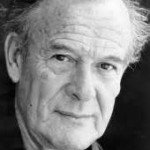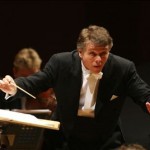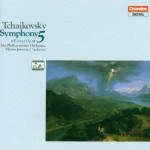My Musical Career|Part Twenty-Six
That First Season…….
That first full season with the Oslo Philharmonic Orchestra was a very interesting one., musically and personally. As I mentioned in an earlier post, I began my tenure as principal timpanist with the Oslo Philharmonic Orchestra (called solopaukist in Norwegian) on September 7, 1983. The program for that
week’s concert consisted of two works: The Symphony No. 8 by the Norwegian composer Harald Sæverud, and the First Piano Concerto by Johannes Brahms. The conductor was Karsten Andersen (1920 -1998), who at that time was the music director of the Bergen Philharmonic Orchestra (which at that time went by its original name Musikselskabets Harmonien). Originally hailing from Fredrikstad, Karsten Andersen was a violinist of repute and leader of a string quartet, who became of conductor of some excellence. He was a fine musician, and a particularly excellent accompanist. He had a great ear and worked extremely well with soloists. The orchestra respected him and played well enough for him, although his beat at times could be a bit nebulous. He was a practical musician who knew when to rehearse and when not to. I remember one program under his direction which featured the Brahms First Symphony as the concluding work. Having just done it in the previous season with the orchestra, Karsten rehearsed the orchestra in the more unfamiliar works, and then dismissed the orchestra early, saying that there was no need to rehearse the Brahms, as the orchestra knew it well enough.I was a relative newcomer to the orchestra at the time and was taken aback by what I perceived to be a lackadaisical attitude towas the symphony, not yet realizing that Karsten was doing something psychological, and trusting the orchestra to perform up to its usual high standard without over-rehearsing what is after all standard repertoire. In the end, his confidence was justified, as the performance was an excellent one.
Back to that first week: the soloist was the Polish pianist Kryzstian Zimmerman, and the collaboration between conductor, soloist and orchestra was incredibly musical. The timpani part for this concerto is not an easy one, and it requires stamina, as well as musicianship and good intonation, and a good sense of interaction with the soloist as well as the orchestra. It was a memorable performance, one which I still remember.
The Symphony No. 8 by Sæverud, called the “Minnesota” was easy to listen to and well written, and Karsten Andersen had this music well in hand. All in all, it was a good way to begin my tenure with the orchestra.
My first tour with the orchestra…working with Mariss
That first season was memorable in many other respects. My first run-out with the orchestra took place in October of 1983, when the orchestra made a overnight trip to Gothenburg, Sweden. Mariss Jansons was back with the orchestra, and the program included one of the suites from the Hundred Hardanger Tones composed by Geir Tveitt. This is wonderful music, which deserves more of a hearing than its gets in the States. One of the movements is called “Domedag” – which has a very tricky part for the timpani – it is a doubling of the bass line in triplets and requires great agility in the pedaling. The main work on the program was an old friend of mine – Rachmaninov’s Symphonic Dances, op. 45. This was the work that launched my Albany Symphony career. It was a huge difference to play this on a great set of timpani. The Hingers were ideal for this work, although I had not yet had the chance to replace the clear Remo heads with the hazy, which I preferred at the time.
The trip to Gothenberg was by bus. The orchestra charted three buses and a truck for instruments and clothes trunks. We left early on a clear October morning. The trip took five hours, and I got a chance to sit with Per Erik Thorsen, our principal percussionist. He felt, rightly, now that I was with the orchestra that it was time for me to commence my Norwegian lessons. We spent a couple of hours discussing the singular and plural for simple word such as cow – kuh – cows – kuer.
The concert was performed that evening at the Konserthus in Gothenburg, which was and is the home of the Gothenburg Symphony, which to this day remains one of Sweden’s premiere orchestras. The hall was older than the Oslo Konserthus, and the cherry red seating plus the Art Deco interior reminded me a little of a movie theater, but the acoustics were much better than in Oslo. It was a pleasure to be able to hear oneself on stage, and the orchestra responded magnificently to the ambience of the excellent acoustics.
The concert was a great success. Mariss was, as usual, at the top of his game, leading an excellent program that included the aforementioned Tveitt “Suite from the Hundrad Hardangartonar” and the Rachmaninov “Symphonic Dances.”
As this tour was only an overnight run-out, this was our only concert, and the orchestra members were pleased with the result.
We returned to Oslo the very next day, and it was a relaxing bus ride back, during the course of which I made the acquaintance of one of the orchestra’s bass players. His name was Karel Netolicka, and he was my seatmate for the return trip. He was a big bear of a man, about fifty-four years of age at the time. Originally from Prague, he was a bass player of immense ability, easily capable of being a principal bass player in any orchestra of the world, but preferring to anchor the bass section as eigth or ninth bass. Our principal bass player later told me that the section deeply respected Karel’s playing, and that he was so solid a player, that he would fit anywhere.
Karel had an interesting career. Too young to have fought in World War II, he watched as his native Czechoslovakia (now Czech Republic) came under the Soviet sphere of influence. He was not particularly happy with that turn of events, but he made the best of a bad situation, and studied with the best instrumentalists of the time. He became a key player in the Prague Chamber Orchestra before he left Czechoslovakia. He went to the States where he was a member of the North Carolina Symphony for a year or two prior to joining the Milwaukee Symphony Orchestra, where he was assistant principal bass for eleven seasons. He returned to Europe for one season as a bass player with the Bavarian Radio Symphony Orchestra before settling in Oslo, first as a member of the Norwegian Radio Orchestra, then as a member of the Oslo Philharmonic.
He lived with his wife in the Stovner section of Oslo, and when I moved to Romsås, he and I used to ride the subway (T-banen) together after concerts. We’d analyze each performance and talk about music and musicians. We got to know each other pretty well, and when he retired from the orchestra in December, 1994, I felt bereft. He never played with the orchestra again, although I did see him a few times on his way to the Opera as a substitute. Eventually, he moved to the USA and settled in Seattle near his daughter and her family. He passed away in 2006. I will never forget his warm-heartedness and his enthusiasm for music and musicians in general.
Recording with the Orchestra – the beginning of the Tchaikovsky cycle
Up until this point, the orchestra only recorded music by Norwegian composers, and of those, almost entirely contemporary. The Norwegian Cultural Council was one of the sponsors, and had sponsored a series of recordings of the music of Edvard Grieg, of which the Norwegian Dances and Lyric Suite were the last in the series.
Mariss had conducted this series, and with my predecessor, recorded the Finn Mortensen Symphony.
Not much was scheduled in the way of recordings for the 1983-84 season, but it was made known to me from my colleagues who sat on the Program Committee that Mariss was keen on recording some of the standard repertoire, but was always stymied by the question “Who would agree to release and promote the recordings?” After a lot of back on forth on this issue, it was decided and agreed that the orchestra
The sessions were held in the Oslo Konserthus (as were all subsequent recording sessions). There were at least two sessions that I recall, the first being on a Friday morning, and the second on an otherwise free Saturday morning in January. Unlike the recording sessions for the Grieg Norwegian Dances, members of the orchestra were allowed into the recording room (it was the NRK recording room loaned to the orchestra for the occasion) to listen to playbacks. It was the first time I took part in that privilege, and I was amazed at how much adjusting I had to do to make my contribution more than just average.
By this time, I had changed the heads on the Hingers from the clear Remos that were on them when I arrived in Oslo, to a set of Remo hazy heads, which were much warmer in tone. For mallets, I used a combination of Hinger wood-shafted generals and medium hards, and Andrew Feldman greens.
In general, I was pretty pleased with my contribution and looked forward to the result. At this point, we still didn’t know if our efforts would even reach the stage of being transferred from tape to vinyl (and later CD). Only time would tell.





Recent Comments